|
DID
YOU KNOW.....
FOOTBALL
MEMORABILIA
Football has a million
and one stories and just as many facts and figures. Here are a few of them
- the record-breaking, unusual and bizarre. More
Did You Knows...
Index
1 2
3 4
5 6 7
8 9
10 11
12 13
14 15
16 17
18 19
20
21 22
23 24
25 26
27 28
29 30
31 32
33
34
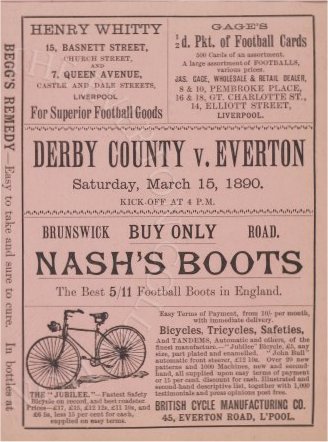 Over
the years surely programmes have been the most collected item of football
memorabila. When I first started attending matches - in the
1960's - the only souvenirs you could buy at Peterborough United matches
were the match-day programme, a rosette and - if you could find the
Supporters Club secretary - a club badge. So programmes it was. By far the
best one-club collection of programmes - and memorabilia in general - is
the 'Everton Collection'. A museum-quality collection of programmes
from before the formation of the Football League as well as photographs,
shirts, caps, contracts, minute-books and just about everything else that
charts the progress of the clubs from its formation to the present day. Over
the years surely programmes have been the most collected item of football
memorabila. When I first started attending matches - in the
1960's - the only souvenirs you could buy at Peterborough United matches
were the match-day programme, a rosette and - if you could find the
Supporters Club secretary - a club badge. So programmes it was. By far the
best one-club collection of programmes - and memorabilia in general - is
the 'Everton Collection'. A museum-quality collection of programmes
from before the formation of the Football League as well as photographs,
shirts, caps, contracts, minute-books and just about everything else that
charts the progress of the clubs from its formation to the present day.
*********
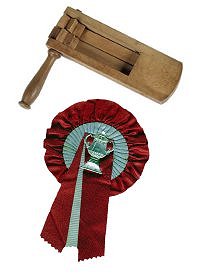 I
was at an FA Youth Cup match the other day and sat behind someone who had
a rattle. I always thought there was a time when everyone under 16 who
attended a football match had a rattle but thinking about it I couldn't
remember another time when I had ever heard a rattle at a match. I guess
nowadays at a 'proper' match they would be confiscated as being a
dangerous weapon. But definitely a genuine piece of footballing
memorabilia as is the rosette. OK you still see rosettes around but not in
the quantity that were around up to the end of the 1960's. There was
always a man with a wooden contraption which not only sported rosettes of
the two clubs you were watching that afternoon but seemingly every other
club in the country as well. And in those days you just didn't feel a
complete wassock by wearing one! I
was at an FA Youth Cup match the other day and sat behind someone who had
a rattle. I always thought there was a time when everyone under 16 who
attended a football match had a rattle but thinking about it I couldn't
remember another time when I had ever heard a rattle at a match. I guess
nowadays at a 'proper' match they would be confiscated as being a
dangerous weapon. But definitely a genuine piece of footballing
memorabilia as is the rosette. OK you still see rosettes around but not in
the quantity that were around up to the end of the 1960's. There was
always a man with a wooden contraption which not only sported rosettes of
the two clubs you were watching that afternoon but seemingly every other
club in the country as well. And in those days you just didn't feel a
complete wassock by wearing one!
*********
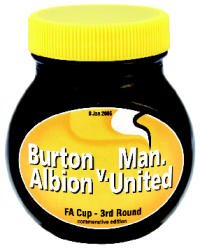
Now
have you got this unique item in your memorabilia collection? When Burton
Albion - then a non-league side - drew Manchester United at home in the
Third Round of the FA Cup in January 2005 a Burton company wanted to mark
the occasion with a commemorative limited issue of their product -
Bovril! This they did, with labels in yellow for Burton fans and red for
United supporters. Burton held the mighty Manchester United in the first
match but lost 0-5 in the replay at Old Trafford.
*********
I'm sure all football fans of a
certain age will have had an autograph book although ebay may have parted
many of us from keeping them. There was a time when football players would
happily sign anything put in front of them, often even if you knocked on
their front door. In the long-distant past I even
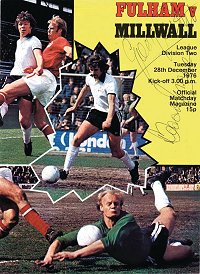 sent
my book through the post to a number of clubs and got back a full set of
signatures from every player on the books. Somehow now I don't think that
you would even trust the Royal Mail to get them delivered but sadder still
it seems to be too much bother now for players to sign autographs for
free. Apart from a touch of arrogance many of the impoverished stars can
make a small fortune for themselves by signing photos, shirts and balls
for the commercial autograph market. It's big business, look at the prices
for a Bobby Moore or Alf Ramsey signature. But it's true memorabilia. I
defy any football fan - let alone Fulham fans - not wanting a Fulham
programme from the 1970s which has the autographs of Fulham team-mates
Bobby Moore and George Best on the cover. The memories that item would
bring back - sad it was up for sale at £1250 in 2012! sent
my book through the post to a number of clubs and got back a full set of
signatures from every player on the books. Somehow now I don't think that
you would even trust the Royal Mail to get them delivered but sadder still
it seems to be too much bother now for players to sign autographs for
free. Apart from a touch of arrogance many of the impoverished stars can
make a small fortune for themselves by signing photos, shirts and balls
for the commercial autograph market. It's big business, look at the prices
for a Bobby Moore or Alf Ramsey signature. But it's true memorabilia. I
defy any football fan - let alone Fulham fans - not wanting a Fulham
programme from the 1970s which has the autographs of Fulham team-mates
Bobby Moore and George Best on the cover. The memories that item would
bring back - sad it was up for sale at £1250 in 2012!
*********
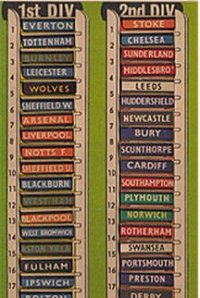 There
is one piece of footballing memorabilia I have always thought of as being
pointless - the League Ladder. At their most popular in the 60s and 70s
they were given away in comics such as Lion, Valiant and Shoot - and
amazingly in the era of computers they are still being produced. A
cardboard chart with the (then) six England and Scottish divisions with a
slot for each place into which you carefully placed teams tabs and moved
them about each week depending on results. Yes, I fell into the trap of
having them - collecting the ladder and tabs was part of the countdown to
the start of the new season. But what was the point? Because they didn't
show points won or goal average you needed to look at the tables in a
newspaper to get the league positions before you could move all the team
tabs about. Usually the effort lasted until about the third week of the
season before Peterborough United miraculously not only found themselves
promoted to the First Division but well on their way to the League
championship while Northampton were relegated. There
is one piece of footballing memorabilia I have always thought of as being
pointless - the League Ladder. At their most popular in the 60s and 70s
they were given away in comics such as Lion, Valiant and Shoot - and
amazingly in the era of computers they are still being produced. A
cardboard chart with the (then) six England and Scottish divisions with a
slot for each place into which you carefully placed teams tabs and moved
them about each week depending on results. Yes, I fell into the trap of
having them - collecting the ladder and tabs was part of the countdown to
the start of the new season. But what was the point? Because they didn't
show points won or goal average you needed to look at the tables in a
newspaper to get the league positions before you could move all the team
tabs about. Usually the effort lasted until about the third week of the
season before Peterborough United miraculously not only found themselves
promoted to the First Division but well on their way to the League
championship while Northampton were relegated.
*********
Football supporters with an
interest in philately have an almost endless supply of football stamps to
choose from from every part of the world. For England fans there is one
set that would be a must -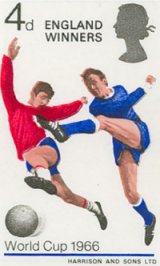 the 1966 World Cup set of three and the one overprinted 'England Winners'.
As a teenager at the time I thought I would make a fortune by getting on
my bike and travelling around the village post offices buying up supplies
of the 'England Winners' stamps which were bound to increase dramatically
in value. Sadly most people seemed to have had the same idea. So it isn't
the stamps that are rare - the print quantity of the stamps was small but
most people kept them as an investment rather than stuck them on envelopes
so they are not at all rare or valuable. But all those village post
offices are now as rare as hens teeth!
the 1966 World Cup set of three and the one overprinted 'England Winners'.
As a teenager at the time I thought I would make a fortune by getting on
my bike and travelling around the village post offices buying up supplies
of the 'England Winners' stamps which were bound to increase dramatically
in value. Sadly most people seemed to have had the same idea. So it isn't
the stamps that are rare - the print quantity of the stamps was small but
most people kept them as an investment rather than stuck them on envelopes
so they are not at all rare or valuable. But all those village post
offices are now as rare as hens teeth!
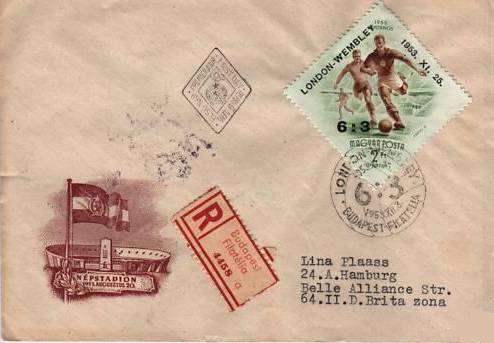 Some
overprints are a bit more painful for England. In 1953 when Hungary became
the first continental country to win in England the 6-3 scoreline hit the
headlines round the world. In Hungary the postal authorities commemorated
the achievement by overprinting a football stamp with the date and score
and even used the score as part of a special postmark. Ouch! Some
overprints are a bit more painful for England. In 1953 when Hungary became
the first continental country to win in England the 6-3 scoreline hit the
headlines round the world. In Hungary the postal authorities commemorated
the achievement by overprinting a football stamp with the date and score
and even used the score as part of a special postmark. Ouch!
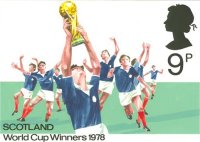 One stamp English fans will be
perhaps be pleased not to have in
their collection was the 1978 World Cup 'Scotland Winners' issue. It was
designed just in case Scotland won it. Fat chance - but unlike England
they at least did reach the finals! One stamp English fans will be
perhaps be pleased not to have in
their collection was the 1978 World Cup 'Scotland Winners' issue. It was
designed just in case Scotland won it. Fat chance - but unlike England
they at least did reach the finals!
Modern football and the postage
stamp both have their origins in Britain but the most innovative football
stamp must surely go the Austrians. In 2008 to mark their co-hosting of
Euro 2008 they issued
a stamp which commemorates a goal scored by Andreas 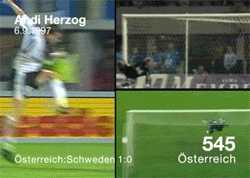 "Andi" Herzog for
Austria in 1997 to help the Austrians reach the 1998 World Cup Finals.
Using lenticular technology it shows moving images of the goal from three
different angles. It's a big stamp - approx 2 x 2.5 inches so there's
not a great deal of room left for the address - and has a face
value of 5.45 Euros. But it moves! "Andi" Herzog for
Austria in 1997 to help the Austrians reach the 1998 World Cup Finals.
Using lenticular technology it shows moving images of the goal from three
different angles. It's a big stamp - approx 2 x 2.5 inches so there's
not a great deal of room left for the address - and has a face
value of 5.45 Euros. But it moves!
*********
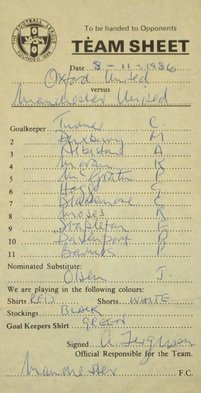 Well,
they say never chuck anything away. Back in 1986 an Oxford United player
of the
time, Peter Rhoades-Brown, gave a fan a souvenir - a teamsheet that had
been hanging up in the dressing room. And the fan kept it, the teamsheet
surviving many a spring-clean until he decided to put it up for sale 27
years later. But it wasn't just any teamsheet, it was for the first team
Alex Ferguson sent out as manager of Manchester United and was
signed by the man himself. The match was played at Oxford's Manor Ground
on Saturday 8th November 1986 and the home side recorded a memorable 2-0 victory. Despite
that unsuccessful start to his United career Fergie became a legend and shortly after he
retired the teamsheet was sold at auction in June 2013. It was expected to sell for
between two and three thousand pounds but when the hammer went down the
winning bid was a mahoosive £19,000. Not bad for a scrappy bit of paper! Well,
they say never chuck anything away. Back in 1986 an Oxford United player
of the
time, Peter Rhoades-Brown, gave a fan a souvenir - a teamsheet that had
been hanging up in the dressing room. And the fan kept it, the teamsheet
surviving many a spring-clean until he decided to put it up for sale 27
years later. But it wasn't just any teamsheet, it was for the first team
Alex Ferguson sent out as manager of Manchester United and was
signed by the man himself. The match was played at Oxford's Manor Ground
on Saturday 8th November 1986 and the home side recorded a memorable 2-0 victory. Despite
that unsuccessful start to his United career Fergie became a legend and shortly after he
retired the teamsheet was sold at auction in June 2013. It was expected to sell for
between two and three thousand pounds but when the hammer went down the
winning bid was a mahoosive £19,000. Not bad for a scrappy bit of paper!
Fergie's team that day - Chris
Turner, Mike Duxbury, Arthur Albiston, Kevin Moran, Paul McGrath, Graeme
Hogg, Clayton Blackmore, Remi Moses, Frank Stapleton, Peter Davenport,
Peter Barnes with the one sub being Jesper Olsen.
*********
The ultimate bit of football
memorabilia? Going to the Match was painted by LS Lowry in 1953 and
won a prize in a competition which marked the 90th anniversary of the
Football Association. It depicts a scene of fans on their way to a match
at Burnden Park, the former home of Bolton Wanderers. Lowry lived close to
the ground but his interest was probably more to do with turning the
crowds into his trademark 'matchstick men' rather than the game itself.
The 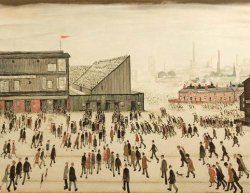 painting was bought by the Professional Footballers Association in
1999 at a Sotherby's auction. PFA Chief Executive Gordon Taylor did the
bidding and said of the painting 'it represents the heart and soul of
the game - the anticipation of crowds going to the match.' How much?
Well in 1999 it cost the PFA £1,926,500 which at the time was a record for a modern
British painting. The PFA cashed in
their investment in October 2022 and made a decent profit. It was sold by
Christie's for £6.6m with an additional buyers premium increasing the
cost to the buyer to £7.8m. painting was bought by the Professional Footballers Association in
1999 at a Sotherby's auction. PFA Chief Executive Gordon Taylor did the
bidding and said of the painting 'it represents the heart and soul of
the game - the anticipation of crowds going to the match.' How much?
Well in 1999 it cost the PFA £1,926,500 which at the time was a record for a modern
British painting. The PFA cashed in
their investment in October 2022 and made a decent profit. It was sold by
Christie's for £6.6m with an additional buyers premium increasing the
cost to the buyer to £7.8m.
*********
The Football League Review
has proved to be very collectable since its demise in 1974. It started
life as the Soccer Review in August 1965, was taken over by the
Football League and renamed the Football League Review the
following season and
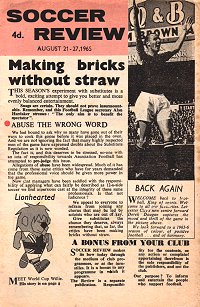 had
become League Football by the time of its last edition in December
1974. OK it had its trivial bits, colour photos of players and teams,
stats, letters etc etc but it also covered Football League affairs -
everything from referees to the Benevolent Fund - in the sort of detail
that would not have been attempted by the likes of Soccer Star or
Football Monthly. The idea was that the Football League would
produce it and sell at a discount to clubs who would include it in their
match-day programme. Sadly it never made money and at its most popular was
only taken by 73 of the 92 clubs (mostly the smaller clubs) with a
circulation of up to a quarter of a million a week. Sadly missed - it
often proved far more readable than the programme it was included in! had
become League Football by the time of its last edition in December
1974. OK it had its trivial bits, colour photos of players and teams,
stats, letters etc etc but it also covered Football League affairs -
everything from referees to the Benevolent Fund - in the sort of detail
that would not have been attempted by the likes of Soccer Star or
Football Monthly. The idea was that the Football League would
produce it and sell at a discount to clubs who would include it in their
match-day programme. Sadly it never made money and at its most popular was
only taken by 73 of the 92 clubs (mostly the smaller clubs) with a
circulation of up to a quarter of a million a week. Sadly missed - it
often proved far more readable than the programme it was included in!
*********
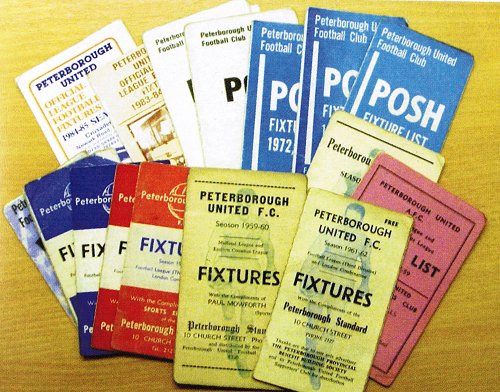
There was a time when the first sign
of a new season was getting your club fixture card, it was something most
of us looked out for. It was a great advert for the printer - often the
local newspaper - and although it was a must-have for the start of the
season it soon became out of date. League dates did change and cup matches
had to be written in so after a short they did become a tad tatty. I
haven't seen a newly-issued one for years, I guess the internet pretty
much guarantees that they remain something very much from the past.
*********
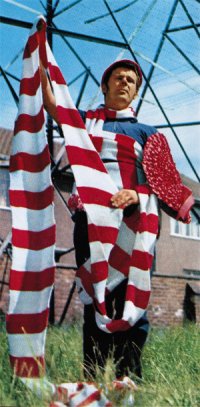
Well, there are a million and one different types of scarves you can buy
nowadays but there was a time, before the invention of club shops, when
the only club item you could wear was a club scarf - and you had to find
someone to knit it for you!
Back in 1979 the self-proclaimed
King of the Scarves was one Richard Pedder, a Liverpool fan, who claimed
to have the longest scarf in the world - a 30 footer! He obviously didn't
knit it - in those days that was a women's job (sorry, I'm joking!)
so the real credit should surely go to the knitter, Richard's work
colleague Sarah Brown, who took four months to complete the task. Although
Richard did make his own rosette to accompany the scarf - and that was 18
inches in diameter!
And for those of you who love stats
there were around 201,600 stitches in that scarf - that's 84 rows a foot
and 80 stitches in a row!
*********
Peter Adolph, the creator of
Subbuteo, first advertised the table-top football game from his home
in August 1946. Not that he had anything to sell at the time, it was only
when the orders started to arrive that he turned his idea into an actual
product. The first Subbuteo sets were eventually ready in March
1947 and they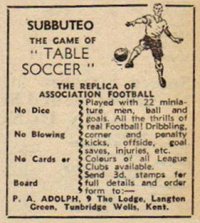 were very different from the current professional product. Then the game
consisted of cardboard playing figures (available in red or blue kits)
with their bases being buttons weighed down with lead washers. The goals
were made of wire with paper nets and no pitch was included although chalk
was provided along with instructions how to mark out the playing area on
an old blanket.
were very different from the current professional product. Then the game
consisted of cardboard playing figures (available in red or blue kits)
with their bases being buttons weighed down with lead washers. The goals
were made of wire with paper nets and no pitch was included although chalk
was provided along with instructions how to mark out the playing area on
an old blanket.
The origins of the name Subbuteo?
Originally Peter Adolph wanted to call the game Hobby but he wasn't to
claim a trademark on that name. Instead he adapted the Latin name of a
bird of prey, the Eurasian Hobby, which is Falco Subbuteo.
*********
One piece of memorabilia that will
never be worth less than its face value is the Ulster Bank £5 note that
was issued to commemorate the life of that great Ulsterman, George Best.
Being legal tender the note can simply be handed over the counter to
realise its value of £5 but I would guess that few would do that with this
unique souvenir of an amazing player.
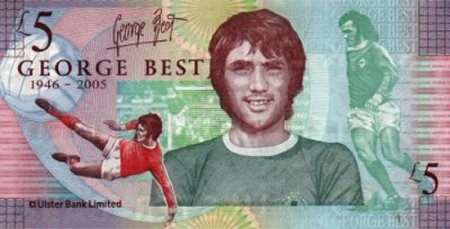
A pet hate shared by
most supporters is of a disloyal player who is seen as greedy. When that
happens its not unusual to find that the player concerned is put on a
banknote of his own as a tribute to that greed. It's far from being legal
tender but it is a genuine piece of football memorabilia all the same.
Wayne Rooney was so honoured during his contract negotiations with
Manchester United at the start of the 2010/11 season. But perhaps greed
does pay - the outcome for him was that he received some 10,000 of the
genuine version of the £20 notes every single week!

*********
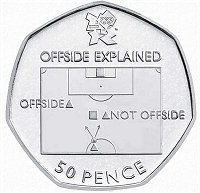 If
you are of more limited financial means how about a 50p souvenir coin? To
celebrate the 2012 Olympics the Royal Mint issued a set of 29 50p
commemorative coins which have images of all the Olympic sports. The
design chosen for the football coin is an explanation of the offside law.
There's no truth in the rumour that the Royal Mint presented one to
all the country's refs and assistant refs! The Royal Mint claimed that
the 29 coins proved to be the most popular sellers since the currency was
decimalised with an estimated 36 million out of the 52 million issued
having been kept by collectors. If
you are of more limited financial means how about a 50p souvenir coin? To
celebrate the 2012 Olympics the Royal Mint issued a set of 29 50p
commemorative coins which have images of all the Olympic sports. The
design chosen for the football coin is an explanation of the offside law.
There's no truth in the rumour that the Royal Mint presented one to
all the country's refs and assistant refs! The Royal Mint claimed that
the 29 coins proved to be the most popular sellers since the currency was
decimalised with an estimated 36 million out of the 52 million issued
having been kept by collectors.
|